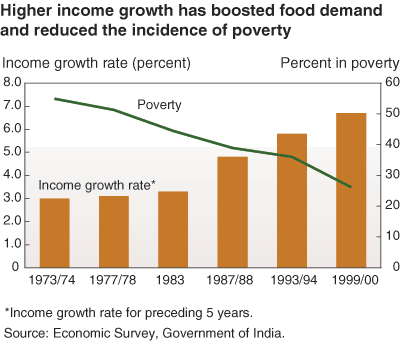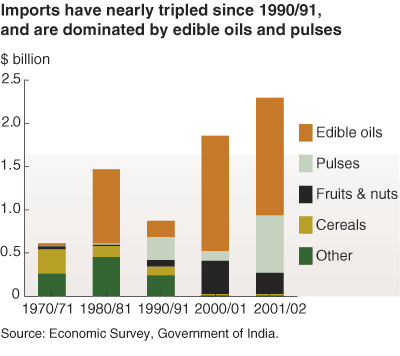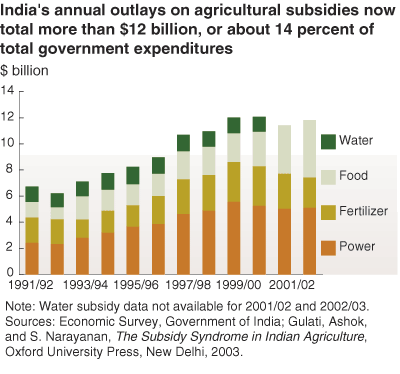The Elephant Is Jogging: New Pressures for Agricultural Reform in India
- by Maurice Landes
- 2/1/2004
Although often characterized as a lumbering elephant compared with the tigers (such as Malaysia and Thailand) and the dragon (China) of Southeast and East Asia, India’s economy and agricultural sector have made remarkable progress in the 57 years since independence in 1947. Endowed with rich land, water, and labor resources, India increased production of its staple cereals from 42 million tons just after independence in 1950/51 to over 188 million by 2000/01—more than a fourfold increase. Much of this gain was driven by the introduction of high-yielding wheat and rice varieties during the Green Revolution period of the late 1960s and early 1970s, combined with supportive price policies and investments in irrigation.
Now, however, the agricultural sector has outgrown the policies that contributed to past success and is facing new pressures as consumer incomes rise. The middle class of the world’s second most populous nation is growing ever wealthier and seeks greater diversity in food products. And, because the average Indian household spends about 55 percent of its income on food—a much higher share than in developed countries—changes in food prices resulting from new domestic and trade policies are also driving changes in food demand patterns.
Indian producers are responding to rising demand with only partial success. Recent trade liberalization measures have introduced new products at lower prices, thus creating competitive pressures for domestic producers. Constraints such as poor infrastructure, inefficient markets, and low investment also hobble Indian producers’ ability to satisfy consumer demand.
Economywide trade and regulatory reforms are improving the investment climate for both domestic and foreign companies in India. But policy reform in agriculture has proven politically difficult, and the pace of reform in that sector will likely be slower than in some other fast-growing Asian economies, such as Malaysia, Thailand, or China. Even so, the past few years have seen an expansion in India’s farm trade. This is not likely to bring short-term benefits to U.S. exporters, since many U.S. products are not price-competitive in India’s market. But there is significant potential for investment in production and marketing.
Economic Growth Begins To Transform Food Demand
After more than three decades of sluggish economic gains stretching from independence to the early 1980s, Asia’s elephant has now broken into a jog. The economy has grown at an annual rate of 5.7 percent since 1980, ranking India among the fastest growing economies. Rapid per capita income growth is now the major force behind the emerging transition of Indian agriculture and policy. Although India is still home to a large share of the world’s poor, the share of the population in poverty is declining, and a significant, relatively affluent, middle class has emerged.
India’s per capita income of about $460 remains low by developed country standards, but actual buying power is more than five times that amount because Indian prices for many goods and services are well below world averages. Middle-class households with buying power well above that average include roughly 150-200 million consumers and constitute the fastest growing segment of the population. Urbanization is also on the rise. Urban dwellers account for about 28 percent of the population, and their share of the population is growing about 3 percent annually.
Higher incomes, particularly in lower- and middle-income households, are having an important impact on food demand in India because these groups tend to spend a relatively large share of their income on food consumption. Middle-income and urban consumers are also likely to spend more of their income on upgrading and diversifying their diets, eating out more often and eating more processed and convenience foods.
Indian food consumption patterns have diversified significantly since the 1980s. Consumption of fruits, vegetables, edible oils, and animal products is rising much faster than that of wheat and rice, staple grains in the Indian diet.
Milk—of which India is now the world’s largest producer—along with eggs and poultry meat are the most important animal products, and all are registering strong growth in production and consumption. Poultry meat is finding broad consumer acceptance, in part due to its low relative price, and the sector is growing 10-15 percent per year—ranking it among the fastest growing poultry sectors in the world.
Despite traditional vegetarian dietary preferences, the growth of the poultry and egg industries is evidence that the expansion of meat and feed demand will play a role in the transformation of Indian agriculture, as it has in other developing countries. In fact, consumer studies suggest that while 20-30 percent of consumers have strict vegetarian preferences, meat consumption by the remaining 70-80 percent is limited more by income than religious preference.
Price Changes Also Drive Food Demand and Trade
Changes in food prices, whether arising from lower import barriers or from improved efficiency of domestic production and marketing, are also playing an important role in India’s food demand and trade. Because such a large proportion of income is spent on food, consumers are more likely to adjust the amounts and types of food they buy when prices change. Recent developments illustrate the increased influence of world prices, and of improved marketing efficiency, on consumption and trade:
- Poultry meat consumption is sharply higher in southern India, primarily because large, integrated producers have significantly reduced marketing costs and consumer prices in the region.
- A sharp increase in edible oil consumption since the mid-1990s stems from larger imports and lower domestic prices following the reduction of import barriers. Low relative prices for imported palm oil, which was not traditionally consumed in India, have made it the single largest oil used in India.
- India’s pulse imports have surged recently because of a low tariff and increased global supplies of low-priced white peas. Although not traditionally consumed in India, white peas have gained acceptance due to their low price.
Trade Liberalization Has Brought Increased Imports of Some Products . . .
Faster income growth, together with lower import barriers, helped to more than double India’s farm imports during the 1990s to $1.9 billion in 2000/01. Complying with World Trade Organization (WTO) rules, India removed all quantitative barriers to agricultural imports by 2001 and voluntarily reduced tariffs below required levels for a number of commodities, including edible oils, pulses, and cotton.
As a result of trade liberalization, India is now the world’s largest market for edible oils and pulses. In general, India has chosen to liberalize imports of those products where domestic production is least competitive. Edible oil imports—about two-thirds of which are low-priced palm oil—now account for about half of domestic oil consumption. Imports of pulses, widely used in traditional Indian meals, averaged more than 2 million tons during 2001/02 and 2002/03, up from just 0.4 million in 2000/01. These imports are mostly low-cost varieties of chickpeas (garbanzos) and peas (mainly white peas, but also including some green peas). Imports of raw cotton—a primary input for India’s large textile sector—have also been on the rise, primarily to meet the quality needs of textile exporters.
For other products, however, including most high-value consumer items such as fresh fruits and processed foods, India has chosen to protect domestic production by imposing high tariffs. Apples, for example, face a 50-percent tariff. Most processed and packaged foods—including canned goods, cereal preparations, and packaged meats—face import duties of 50 to 150 percent. This high border protection has dampened overall imports of consumer food products, but their recent upswing testifies to the rising purchasing power of India’s higher-income consumers.
These trends have brought only limited benefits to U.S. agriculture. U.S. agricultural exports to India, consisting primarily of raw cotton and almonds, accounted for just 15 percent of India’s total agricultural imports between 2000 and 2002. A key constraint on U.S. sales is that many U.S. products, particularly soybean oil and pulses, have not been price-competitive in the Indian market.
. . . But Agriculture, Despite Subsidies, Suffers From Low Productivity and Under-Investment
Consumer demand for greater variety, coupled with more liberal import policies, is pressuring India’s producers and marketing system to provide a broader range of products at competitive prices. But Indian agriculture is characterized by low productivity, with average crop yields well below world levels. Large investments, public and private, are needed to improve seed varieties and improve irrigation and plant protection practices. Government agencies are promoting diversification in production, research, and farm extension. But successful diversification is likely to require shifting public resources away from subsidies and improving incentives for private investment.
Historically, India’s agricultural policies sought to ensure self-sufficiency in two staple grains, wheat and rice. That focus continues today, even though current grain production is more than enough to satisfy consumer demand. Through the “food subsidy,” the Indian Government covers the cost of price support, distribution, and storage of wheat and rice—totaling about $4.4 billion in 2002, equivalent to 5 percent of all government expenditures (see “Food Grain Surplus Signals Need for Policy Change”). The government also subsidizes other farm inputs, including fertilizer, power, and irrigation water. The total subsidy bill has now grown to more than $12 billion annually—far exceeding both public ($1 billion in 2001/02) and private ($2.8 billion) investment in agriculture.
Rising subsidies and a large overall public sector deficit have dampened public investment in agriculture. Although private investment has grown, it remains small, amounting to only about 1.4 percent of agricultural output, compared with 24 percent for the economy as a whole. Private investors have, historically, been discouraged by an array of market regulations and licensing requirements that, among other things, have restricted private storage and movement of major farm goods and limited the scale of food processing plants.
Weak incentives have led to significant underinvestment in agricultural marketing and processing, as well as production. Marketing chains are highly fragmented, often including six to eight intermediaries, and are dominated by small-scale enterprises. Rural road and transport infrastructure remains poor and relatively costly. Because markets are inefficient, farmers tend to receive a small share of the consumer price—only about 25 percent in the case of unprocessed vegetables. Physical losses in the food chain are high as well—roughly 40 percent for horticultural products. Inefficient marketing also raises the cost of imported foods, as high margins taken by wholesalers, retailers, and intermediaries exacerbate the effect of high tariffs.
Vertical integration—the consolidation or coordination of production and processing stages by one firm—is a common feature of efficient food marketing systems in other large agricultural economies, but is nascent in India. Only about 4 percent of output is processed, and only a handful of food processors have annual turnover as large as $150 million—a scale considered small in many other developed and developing countries. Even with more than 1 billion consumers and a retail food market estimated at $133 billion, small “Pop & Son” shops still dominate retail food sales. Organized chain stores are emerging and expanding rapidly, but at present account for only about 1 percent of food sales.
Major Agricultural Policy Reform Remains Politically Difficult . . .
India’s improved economic growth has stemmed largely from major domestic and trade policy reforms in the industry and service sectors in the early 1990s. Complementary reforms in agriculture have proven more difficult. Political consensus on major agricultural reform remains elusive, in part because of reform’s potential impacts on food prices and employment—agriculture accounts for 60 percent of India’s employment. In addition, price support and input subsidy policies, which primarily benefit producers of wheat and rice in surplus regions, have proven difficult to withdraw despite the stockpiling of grain.
The most significant policy changes in the sector have been in market access, including the WTO-required liberalization of import policies completed in 2001. Longstanding restrictions on farm exports that taxed local producers and precluded competitive export industries began to lessen in the mid-1990s. These reforms helped stimulate trade, including the rise in edible oil imports and increased exports of rice and wheat. But they have also exposed the inefficiencies of the domestic marketing system, including high transport and handling costs, small-scale and inefficient milling and processing, and lack of food grading and inspection services.
. . . But the Seeds of Policy Reform Are Being Planted
Many policies that have, historically, weakened private investment incentives and contributed to India’s fragmented, small-scale, and inefficient marketing system are now being changed. The central government and several state governments have lifted longstanding measures that restricted private storage and interstate movement of grain and other essential foods. Licenses are no longer needed to establish food-processing firms, and regulations restricting their size have been mostly eliminated. In addition, foreign direct investments (FDI) in food processing and marketing—with the exception of retail marketing—are now automatically approved for investments up to 51-percent equity.
Other key changes are underway that should improve the climate for investment. One is establishing legal frameworks to protect both farmers and processors in contract farming agreements, and to enforce those agreements. With Indian agriculture dominated by small-scale holdings of only about 2-½ hectares, food processors struggle to procure adequate supplies of high-quality produce. Contract farming is already expanding in some regions and products, including broilers in Tamil Nadu and Maharashtra and vegetables in Punjab, and has proved successful at reducing marketing risks faced by both buyers and sellers. But contract farming is not recognized or protected by current laws, and the practice could expand more rapidly with stronger legal protections in place.
A related reform now under discussion would involve changes in current laws governing the leasing of agricultural land. At present, inadequate protections for both lessors and lessees limit the use of land rental to assemble larger, and potentially more efficient and competitive, holdings.
Another anticipated reform is the streamlining of food safety laws and their alignment with international standards. Indian food law now falls under five outdated statutes, with jurisdiction spread across four ministries, thus greatly increasing the cost and complexity of compliance. A major revamp of the food law aimed at consolidation of responsibilities and jurisdiction, as well as closer links to international standards, is now underway, although there is no clear time frame for its completion.
A relaxation of the current ban on FDI in retailing, should it occur, could also have a big impact on the transformation of India’s food markets by providing an infusion of capital and expertise, as well as promoting linkages and standards backward through the marketing chain. Several large Indian firms have announced ventures in food retailing. FDI has already begun to flow into wholesale food distribution in Bangalore.
Emerging Trade and Investment Trends
The pace of change in agricultural policy, trade, and investment in India is likely to remain closer to that of an elephant than a dragon or tiger. Achieving political consensus for significant change in agriculture remains a slow process, even as economic imperatives become clear. Gradually, regulatory and policy change is helping transform agricultural markets, creating opportunity for trade and investment.
India’s agricultural imports will probably continue to be dominated by basic commodities—such as edible oils and pulses—where price competitiveness will remain the key to boosting trade. The extent to which India emerges as a major global market for other commodities—such as feed grains—will hinge on how successfully it exploits its rich resources and boosts farm productivity. Similarly, future trends in high-value product trade will be driven not only by demand, but also by success in diversifying production, and building a modern, market-oriented agricultural marketing system.
Indian import demand is likely to remain extremely price-sensitive, and this will continue to hinder U.S. exports to that market. While trade prospects may be limited, there could be opportunities for investment. India appears poised for an expansion of investment to modernize agribusiness, including input supply, distribution and marketing, and food processing. Significant investment opportunities are likely in the markets for both basic and high-value foods, where demand can be driven by rising incomes and price reductions achieved through increased integration and efficiency in the supply chain. Huge annual investments, estimated by some at more than $30 billion, will be needed for this transformation and, if the policy climate continues to improve, foreign direct investment could play a key role.
This article is drawn from:
- Landes, M., Price, G. & Govindan, A. (2003). India's Pulse Sector: Results of Field Research. U.S. Department of Agriculture, Economic Research Service. WRS-03-01.
- Dohlman, E., Persaud, S. & Landes, M. (2003). India's Edible Oil Sector: Imports Fill Rising Demand. U.S. Department of Agriculture, Economic Research Service. OCS-090301.
- Landes, M., Persaud, S. & Dyck, J. (2004). India's Poultry Sector: Development and Prospects. U.S. Department of Agriculture, Economic Research Service. WRS-04-03.




